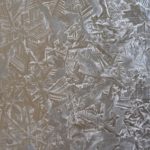Galvanized vs Galvannealed
When specifying doors that are to be exposed to corrosive environments it is important to know all the options available.
Steel doors offer high performance and longevity. In most applications standard cold rolled steel, coated with rust inhibiting primer, will hold up well. When extra protection is needed galvanized steel is a consideration. The steel door industry offers A40, A60 and G90 as typical options.
For harsher conditions you may consider fiberglass which I will cover via a separate post.
Here is a brief explanation of some of the processes and terminology to assist you in selecting the best product for your application.
A60 vs G90, That is the Question
The most common specified are A60 and G90. To understand the difference let’s start with the A and G designations. G denotes galvanized and the A, galvannealed. Both products start out as cold rolled steel sheets. The next step for both coatings is a nice hot bath.
Galvanized
 Galvanization is the process of applying a protective zinc coating to steel or iron, to prevent rusting. The most common method is hot-dip galvanizing, in which the cold rolled steel sheet is submerged in a bath of molten zinc. The zinc bonds to the iron in the steel creating a protective layer on both sides of the sheet.
Galvanization is the process of applying a protective zinc coating to steel or iron, to prevent rusting. The most common method is hot-dip galvanizing, in which the cold rolled steel sheet is submerged in a bath of molten zinc. The zinc bonds to the iron in the steel creating a protective layer on both sides of the sheet.
Galvanized metal is characterized by a shiny spangled finish.
Galvannealed
 To achieve a galvannealed metal, after it emerges from the molten zinc bath the steel continues through an annealing process that converts the zinc to a zinc-iron alloy coating, producing Galvannealed material.
To achieve a galvannealed metal, after it emerges from the molten zinc bath the steel continues through an annealing process that converts the zinc to a zinc-iron alloy coating, producing Galvannealed material.
Galvannealed metal appears dull grey without the spangled effect.
40, 60, 90
The number portion of the equation references the amount of zinc coating applied to the steel sheets. The amount of zinc is controlled and measured to industry standards.
Zinc coatings are measured by weight in ounces per square foot and represents the average of both sides of the steel sheets. In the instance of A60, 60 = .60 ounces of zinc coating per square foot and therefore has greater rust protection than A40.
Common coating weights in the steel door industry include A40, A60 and G90.
Which is best?
Each of the above provides protection against rust and certainly performs better than cold rolled steel. But there is the question of which one is best when selecting hollow metal doors and frames.
This discussion typically centers around A60 vs G90. At first look, the G90 may stand out to offer the best protection. While it is true that this product has more zinc coating per square foot than A60 there are other things to consider.
During the fabrication process of doors and frames the steel sheets are formed, welded and the final product is then painted. Galvanized material does not perform optimally under these processes. The additional annealing process greatly improves formability and paint adhesion.
Specifying galvannealed with a rust inhibitive primer is the best option.
Be sure to check out our meskerdoor.com for additional products and information.
